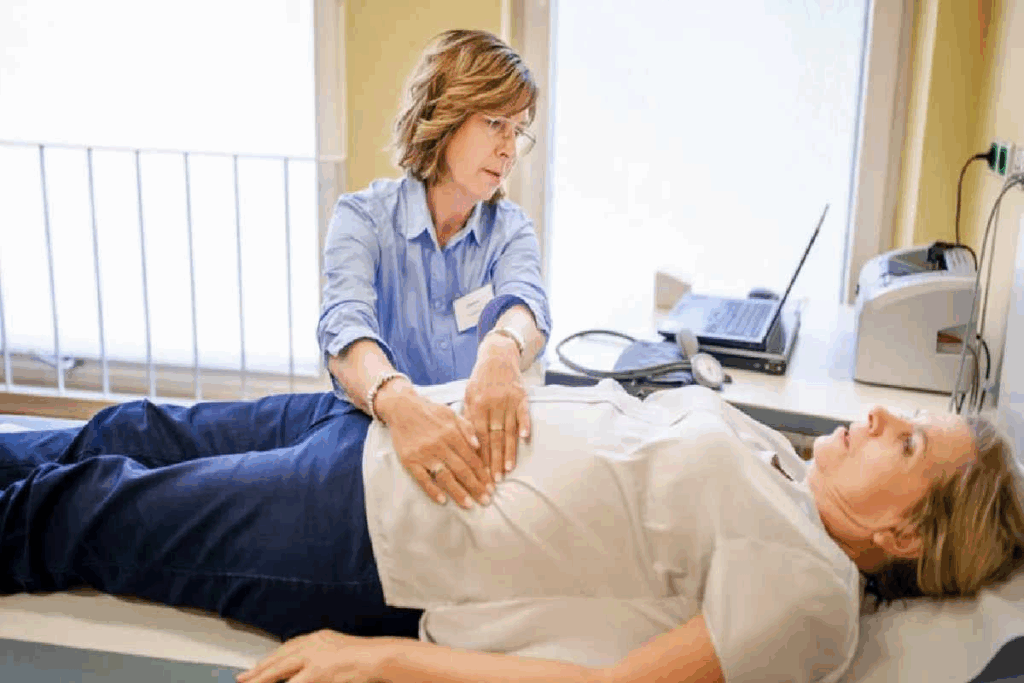Last Updated on October 30, 2025 by Bilal Hasdemir

Knowing about the human digestive system is key to staying healthy. A helpful tool is the colon picture. The colon, or large intestine, is a big part of our digestive system. It goes from the cecum to the anal canal.See colon picture examples with diagrams and anatomy images to understand colon structure easily.
It helps absorb water and salts from the food we eat. This makes the waste we pass.
There are many kinds of colon pictures, like diagrams, photos, and anatomy images. They give us a close look at how the colon works. These pictures are important for doctors and people who want to learn about our digestive system.

Visual aids like human colon images are key for learning about the colon’s anatomy and diagnosing diseases. They help doctors and patients see where conditions like colorectal cancer or inflammatory bowel disease are located. The colon is about 150cm long and has four parts: ascending, transverse, descending, and sigmoid.
Understanding the digestive system’s complex anatomy is easier with visual aids. Human colon images give a clear view of the colon’s structure. This helps both students and professionals grasp its different parts and their roles.
Visual tools like colon images greatly improve patient education. By seeing the colon and its conditions, patients can understand their diagnosis and treatment better. This leads to better health outcomes for them.
| Colon Section | Function |
| Ascending Colon | Water absorption |
| Transverse Colon | Further water absorption and storage of fecal matter |
| Descending Colon | Storage of fecal matter |
| Sigmoid Colon | Temporary storage of feces until elimination |

Colon pictures are key in medical education and diagnosis. They show the colon’s structure and function. The large intestine has unique features like omental appendices and teniae coli. Knowing these features is important for accurate diagnosis and treatment.
Anatomical diagrams and clinical photos are main types of colon pictures. Anatomical diagrams are detailed illustrations of the colon’s structure. They help students learn about the colon’s anatomy.
Clinical photos show real-life images of the colon during procedures. They are great for diagnosing conditions and planning treatments. These photos give a realistic view of the colon’s condition.
Medical imaging technology has led to digital renderings of the colon. These 3D models can be rotated and viewed from different angles. They are useful for surgical planning and patient education.
Traditional illustrations have been used for decades. They are simple and clear. They are often used in educational materials and can show specific anatomical details well.
Both digital renderings and traditional illustrations have their uses. The choice depends on the user’s needs, whether for detailed surgical planning or general education.
Anatomical diagrams of the human colon are key for understanding its structure and function. They are vital in medical education. They help students and professionals understand the colon’s anatomy.
The human colon is divided into four main parts: the ascending, transverse, descending, and sigmoid colon. Each part has unique features and clinical importance. Diagrams and models are essential for showing these differences.
Cross-sectional diagrams give a detailed look at the colon’s internal structure. They are great for learning about the colon wall’s layers, including the mucosa, submucosa, muscularis, and serosa.
Three-dimensional models offer a full view of the colon’s anatomy. They help understand its spatial relationships with other abdominal structures.
Experts says, “3D models of the colon are very useful in surgical planning and patient education. They provide a clear view of the colon’s anatomy.”
“The use of 3D models in medical education has changed how we teach anatomy. It’s a big step forward in making learning more engaging and effective.”
Labeled diagrams are key for learning, as they clearly show different parts of the colon. These pictures are used a lot in textbooks and educational resources. They help students learn the colon’s anatomy.
| Colon Segment | Anatomical Features | Clinical Significance |
| Ascending Colon | Located on the right side, involved in water absorption | Critical for fluid balance |
| Transverse Colon | Crosses the abdomen from right to left | Important for storage and mixing of fecal matter |
| Descending Colon | Located on the left side, continues the process of water absorption | Significant in the formation of solid stool |
Comparative anatomy diagrams show the differences between normal and abnormal colon anatomy. They are very useful in clinical settings for diagnosis.
For example, these diagrams can help identify issues like colon cancer or inflammatory bowel disease. They compare normal anatomy with diseased states.
Knowing about the different types of anatomical diagrams for the human colon is important for both medical professionals and students. These visual tools help in understanding and remembering complex anatomical information.
Knowing the digestive system’s anatomy is key for doctors and patients. Pictures of the colon and intestines help a lot. The digestive system is a series of organs and structures that break down food and liquids.
Seeing the whole digestive pathway helps us understand how the colon and intestines work. It’s important for teaching both doctors and patients. It makes the digestion process clearer.
Visualizing the whole digestive tract means making detailed images from mouth to anus. This includes the esophagus, stomach, small intestine, and large intestine (colon). These images are key to seeing how each part works together.
Key benefits of full digestive tract visualization include:
A picture of the colon in the body shows its position and relation to other organs. This is very important for surgeons and radiologists.
Contextual anatomy images are useful for:
| Visualization Type | Description | Clinical Application |
| Anatomical Diagrams | Detailed drawings of the digestive tract | Medical education, patient education |
| Clinical Photos | Photographic images of the colon and intestines during procedures like colonoscopy | Diagnostic purposes, patient records |
| 3D Models | Three-dimensional reconstructions of the digestive tract from imaging data | Surgical planning, complex diagnosis |
Knowing the colon’s structure is key for diagnosing and treating gut issues. Sectional colon images are vital in this process. The colon has several segments, each with its own function and features.
The ascending colon is the first part of the colon. It absorbs water and electrolytes from the intestinal contents. Ascending colon images are important for seeing its shape and spotting any issues. These images help us understand how it absorbs water and affects digestion.
The transverse colon crosses the abdominal cavity from right to left. It plays a big role in water absorption and storing feces. Transverse colon visualization through images gives us insights into its function and any problems it might have.
The descending colon is important for fecal formation. Descending colon pictures are needed to check its shape and find any problems like diverticula or tumors.
The sigmoid colon is the S-shaped end of the colon. It’s prone to diverticular disease and other issues. Sigmoid colon images are essential for spotting problems in this area. The sigmoid colon is attached to the back of the pelvis by the sigmoid mesocolon, allowing it to move a lot. Understanding its anatomy through images is critical for diagnosis and treatment.
Diagnostic imaging is key in seeing the colon and finding problems in the gut. Methods like colonoscopy, barium enema X-ray, CT colonography, and MRI help us understand the colon’s shape and how it works.
Colonoscopy photos let us see inside the colon. They help find polyps, tumors, and other issues. These images show both big and small details, like the tiny cells in the colon.
Barium enema X-ray and CT colonography pictures are other ways to see the colon. Barium enema uses a contrast agent to show the colon’s shape. CT colonography makes detailed pictures of the colon. MRI colon visualization gives clear images without using radiation.
These imaging methods, including colonoscopy photos, are vital for making accurate diagnoses and treatment plans. By using CT colonography pictures and other methods, doctors can understand the colon better and find problems early.
There are many types of colon pictures. These include anatomical diagrams, clinical photos, and 3D models. You also have labeled anatomy pictures and diagnostic imaging like colonoscopy photos and MRI colon visualization.
Colon pictures show the colon and its parts. This helps us understand how the digestive system works. They let us see the whole digestive pathway, including the colon and intestines.
Anatomical diagrams show the colon’s anatomy in detail. Clinical photos are real images from medical procedures. Diagrams are great for learning, while photos show the colon as it really is.
Digital rendering makes colon pictures more detailed and accurate. Traditional illustration offers a more artistic view. Digital rendering is often used in education and diagnosis because it’s so precise.
Pictures of the colon in the body help students see how the digestive system works together. They show the colon’s place and how it connects with other organs.
The colon has segments like the ascending, transverse, descending, and sigmoid colon. Sectional images show each segment’s function and importance. This helps in understanding the colon’s role.
To see the colon, doctors use colonoscopy, barium enema X-ray, CT colonography, and MRI. Each method shows the colon in a different way, helping with diagnosis.
Colon pictures help patients understand their condition and treatment. They show the digestive system’s anatomy. This education improves health outcomes.
Labeled pictures of the colon show its anatomy clearly. They help students and healthcare professionals learn about the colon’s structures and functions.
3D models of the colon offer a detailed and interactive view. They help students understand the colon’s complex anatomy and how its parts work together.
Khalil, H. M., et al. (2021). Biliary leakage following cholecystectomy: A prospective population study. Journal of Research in Medical and Dental Science, 9(5), 289-296. Retrieved from https://www.jrmds.in/articles/biliary-leakage-following-cholecystectomy-a-prospective-population-study-84919.html
Subscribe to our e-newsletter to stay informed about the latest innovations in the world of health and exclusive offers!
WhatsApp us